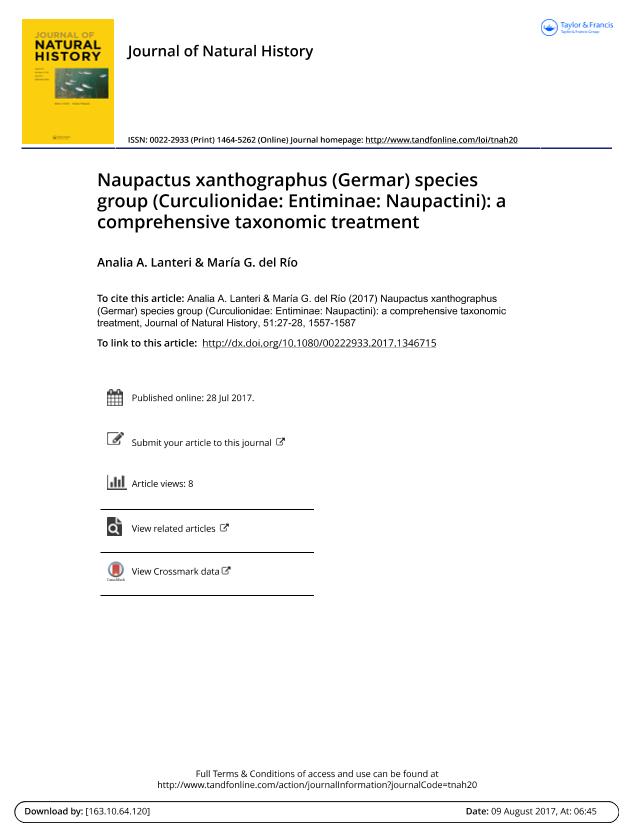Mostrar el registro sencillo del ítem
dc.contributor.author
Lanteri, Analía Alicia

dc.contributor.author
del Rio, Maria Guadalupe

dc.date.available
2018-08-22T18:33:02Z
dc.date.issued
2017-07
dc.identifier.citation
Lanteri, Analía Alicia; del Rio, Maria Guadalupe; Naupactus xanthographus (Germar) species group (Curculionidae: Entiminae: Naupactini): a comprehensive taxonomic treatment; Taylor & Francis Ltd; Journal of Natural History; 51; 27-28; 7-2017; 1557-1587
dc.identifier.issn
0022-2933
dc.identifier.uri
http://hdl.handle.net/11336/56645
dc.description.abstract
We undertake a taxonomic revision of Naupactus xanthographus (Germar 1824) (grape-fruit weevil) and the putative related species N. navicularis Boheman 1840, N. dissimilis Hustache 1947, N. mimicus Hustache 1938, N. dissimulator Boheman 1840 and N. marvaldiae new species. This species group mainly differs from other Naupactus by the presence of a pair of tubercles at the apex of the elytra. It ranges in Argentina, southern Brazil, Bolivia, Paraguay and Uruguay, in areas that belong to the biogeographic provinces of Atlantic, Araucaria and Paraná forests, Yungas, Chaco and Pampa. Naupactus xanthographus is broadly distributed in Argentina, mainly in the Pampean province, and it was introduced in central Chile, where it is considered a serious pest of grapes and several fruit trees. The remaining species are partially sympatric in the subtropical forests of southern Brazil, and N. dissimulator ranges along the gallery forests of Paraná and Uruguay rivers, down to La Plata River. It has been reported damaging citrus and ‘yerba mate’, like N. navicularis and N. dissimilis. The new species N. marvaldiae ranges in southern Brazil and north-eastern Argentina (Misiones), and differs from N. dissimulator, mainly by the very short elytra, the apical tubercles welldeveloped in males and females, the broader front femora, and the different shape of the apex of the penis. The other four species are probably more closely related and they separate from the pair N. dissimulator–N. marvaldiae because of the slightly widened front femora, well-developed corbels of the hind tibiae, and short to indistinct nodulus of the spermatheca.
dc.format
application/pdf
dc.language.iso
eng
dc.publisher
Taylor & Francis Ltd

dc.rights
info:eu-repo/semantics/openAccess
dc.rights.uri
https://creativecommons.org/licenses/by-nc-sa/2.5/ar/
dc.subject
Fruit Weevils
dc.subject
Geographic Distribution
dc.subject
Neotropics
dc.subject
South America
dc.subject
Taxonomy
dc.subject.classification
Otras Ciencias Biológicas

dc.subject.classification
Ciencias Biológicas

dc.subject.classification
CIENCIAS NATURALES Y EXACTAS

dc.title
Naupactus xanthographus (Germar) species group (Curculionidae: Entiminae: Naupactini): a comprehensive taxonomic treatment
dc.type
info:eu-repo/semantics/article
dc.type
info:ar-repo/semantics/artículo
dc.type
info:eu-repo/semantics/publishedVersion
dc.date.updated
2018-08-22T13:02:35Z
dc.journal.volume
51
dc.journal.number
27-28
dc.journal.pagination
1557-1587
dc.journal.pais
Reino Unido

dc.journal.ciudad
Londres
dc.description.fil
Fil: Lanteri, Analía Alicia. Universidad Nacional de La Plata. Facultad de Ciencias Naturales y Museo. División Entomología; Argentina. Consejo Nacional de Investigaciones Científicas y Técnicas; Argentina
dc.description.fil
Fil: del Rio, Maria Guadalupe. Universidad Nacional de La Plata. Facultad de Ciencias Naturales y Museo. División Entomología; Argentina. Consejo Nacional de Investigaciones Científicas y Técnicas; Argentina
dc.journal.title
Journal of Natural History

dc.relation.alternativeid
info:eu-repo/semantics/altIdentifier/doi/http://dx.doi.org/10.1080/00222933.2017.1346715
Archivos asociados
